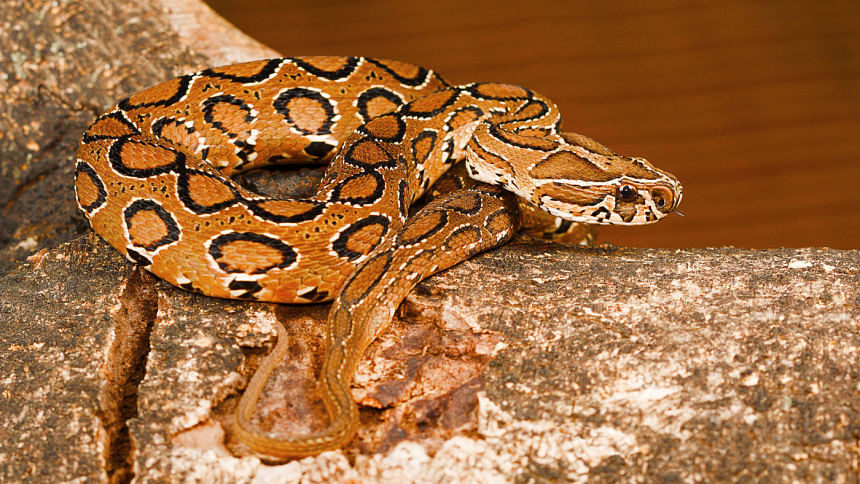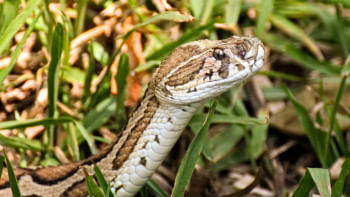Debunking tales of the Russell’s viper

A series of stories have been making rounds on social media, of people dying in different parts of Bangladesh from the bite of the Russell's viper, a venomous snake. In these stories, many circulated by different media outlets, it's claimed that unlike most snakes, this one is hell-bent on biting people and even gives chase to do so. Articles and videos try to establish that the Russell's viper is not native to Bangladesh but is rather slithering its way here from neighbouring countries. Apparently, the snake, which disappeared from the country at one point, has proliferated and is targeting farmers in the fields, and the available antivenoms can barely cure 20 percent of people.
So naturally, people are now in fear of getting attacked by the viper. In many areas, monetary rewards are being declared to kill the snake, which has unfortunately led to people beating pythons to death, mistaking them for the viper. Amid this mass panic, it has become imperative to verify such information, as many of the "facts" being circulated fall in the realm of misinformation.
It is known that the Russell's viper has been named after Patrick Russell, a Scottish herpetologist. In his book An Account of Indian Serpents, Collected on the Coast of Coromandel, published in 1796, Russell stated that the snake has a "highly venomous nature". However, the viper also has a native name: Chandrabora. The article "Phylogeography of the Russell's viper (Daboia russelii) complex in relation to variation in the colour pattern and symptoms of envenoming", published in The Herpetological Journal in 2007, stated that the snake is found in many countries, including India, Sri Lanka, Thailand, Myanmar and Bangladesh. In the article "Russell's Viper (Daboia Russelii) in Bangladesh: Its Boom and Threat to Human Life", published in the Journal of the Asiatic Society of Bangladesh Science in 2018, it's mentioned that two types of the Russell's viper exist, of which "Daboia russelii" is distributed in Pakistan, India, Nepal, Bhutan, Bangladesh and Sri Lanka.
Therefore, it is clear that the snake, contrary to what is being spread, is indeed native to Bangladesh.
According to the latter article, the species was assessed to be "critically endangered" in 2000 and "near-threatened" till at least 2015 in Bangladesh by the International Union for Conservation of Nature (IUCN). The population of Russell's vipers increased as farmers started cultivating two to three times a year, which means crops being constantly available, inviting rats, the main food source of the viper, to be present in the field at all times. With abundant food, the snake can easily reproduce.
This year, at least 10 people, mainly farmers and fishers, have died due to the viper's bite. The snake is now present in at least 25 districts across Bangladesh, according to reports.
Now, let's look into the behaviour of the Russell's viper. The article "Tracking Russell's viper in rural Karnataka unravels their behaviour" published in Mongabay in 2021, stated, "During the study, Glaudas had thousands of close encounters with Russell's vipers but he was never bitten because they are generally hidden in the vegetation... The snakes generally remained motionless, and in some rare cases, fled deeper in the vegetation and/or retracted their head to be more concealed."
Contrary to popular belief, vipers are not aggressive, says researcher Xavier Glaudas, clarifying that an unprovoked attack constitutes aggressive behaviour, and that "Snakes bite in defence, because they are scared of us, and one way to think about it is that they fight for their life when they are confronted with a large moving organism."
So, the claim Russell's vipers are aggressive and chase people to bite them is not supported by research. Now, let's verify the information surrounding antivenom.
Dr Abdul Wahed Chowdhury, associate professor of the Department of Zoology at Chittagong University and co-investigator and supervisor of the Venom Research Centre at Chittagong Medical College, told The Daily Star that this is absolutely false. "The antivenoms available in the country are almost 100 percent effective against the venom of the Russell's viper if people start treatment without wasting time after being bitten," he said. "In some cases, a few people die... they are the very people who came to the hospital very late."
People of rural areas have been living in the presence of snakes for centuries, and only confrontations sometimes lead to accidents, according to researchers. Snakes, which live on small animals, have no sustenance to gain from humans. For example, the Russell's viper's diet comprises rodents, crabs, frogs, lizards and birds. However, humans have much to gain from the presence of snakes, as their existence is essential for the ecosystem.
The stories of snakes chasing humans are only found in tales based on superstitions and fear. They ingrain an idea in people's minds that these creatures are extremely violent. So powerful are these ideas that a good number of movies have been made about sinister snakes in South Asia, many garnering great popularity. One was Nagina, an Indian movie released in 1986, which was the second-highest grossing film in the country that year. The Bangladeshi movie Beder Meye Josna (Daughter of Snake Charmer) made history upon its release in 1989. Starring Anju Ghosh and Ilias Kanchan, the movie has cemented itself as an all-time blockbuster in the history of Bangladesh.
Will the mass panic surrounding the Russell's viper lead to another movie like Beder Meye Josna? While our film industry may get momentum, it's now paramount to fight back against such tales. Mass awareness must be developed; people need to know that the Russell's viper, or any other snake, does not chase people and nor are they aggressive. What's important is to remain cautious about confronting snakes. If bitten, one must immediately rush to the hospital to start treatment. Remember, the sooner the treatment starts, the greater the chances of recovery.
Arun Bikash Dey is a staff reporter at The Daily Star.
Views expressed in this article are the author's own.
Follow The Daily Star Opinion on Facebook for the latest opinions, commentaries and analyses by experts and professionals. To contribute your article or letter to The Daily Star Opinion, see our guidelines for submission.

 For all latest news, follow The Daily Star's Google News channel.
For all latest news, follow The Daily Star's Google News channel. 











Comments